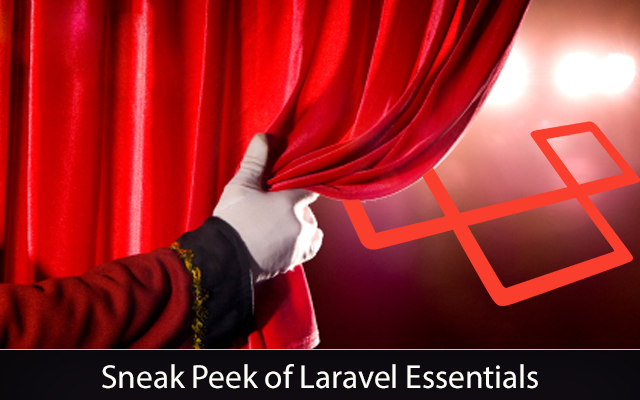Sneak Peek of Laravel Essentials
 With the advent of new PHP frameworks, developing web applications gets easier and better with each new customized framework. New ways of designing and new methods & techniques make applications richer and more interactive. The next time you need to outsource PHP development work to vendors, you should check out the latest frameworks available in PHP which can help you save time and money. Latest frameworks create clean and modular code which ensures a high code readability and easy maintenance.
With the advent of new PHP frameworks, developing web applications gets easier and better with each new customized framework. New ways of designing and new methods & techniques make applications richer and more interactive. The next time you need to outsource PHP development work to vendors, you should check out the latest frameworks available in PHP which can help you save time and money. Latest frameworks create clean and modular code which ensures a high code readability and easy maintenance.Among many frameworks developed in PHP, Laravel stands best in weaving modern customized web applications at quicker time. It envies other frameworks with its out of the box features such as its powerful controllers or slim RESTful routes which helps one build huge enterprise applications. It is popular because of its flexibility and because of the expressiveness it bestows on its sites. It gives an opportunity to modularize the backend code in a simple and readable way which is not possible using other frameworks.

Laravel framework has a huge community where developers and can easily interact and exchange ideas while developing best web applications. Web applications of any size can easily be created using this structure similar to the way that they would be created in other frameworks. Hanging out in the internet relay chart (IRC) channel is a really great way to learn more about web-development using Laravel. And for newcomers in this field it will give a good kick start for a bright career ahead using this latest PHP framework.
Salient points which differentiate Laravel from other frameworks
1. Bundles: It is the modular packaging system of Laravel framework. A bundle repository is already populated with quite a few features that can be easily added to any application off the shelf. One can either download a bundle repository to bundles directory or use the "Artisan" command-line tool to automatically install them.
2. Application Logic: This can be implemented within given application either using controllers (which many web-developers are already familiar with) or directly into route declarations using syntax similar to the Sinatra framework. Laravel is designed with the philosophy of giving a developer the flexibility that they need to create everything from very small sites to massive enterprise applications.
3. Restful Controllers: These are an optional way to separate your GET and POST request logic. In a login example your controller's get_login() action would serve up the form and controller's post_login() action would accept the posted form, validate and either redirect to the login form with an error message or redirect your user to their dashboard.
4. Reverse Routing: It allows creating links to named routes. When creating links one can just use the route's name and Laravel will automatically insert the correct URL. This allows changing routes at a later time and Laravel will update all of the relevant links site-wide.
5. View Composers: They are blocks of code that can be run when a view is loaded. A good example of this would be a blog side-navigation view that contains a list of random blog posts. It contains the logic to load the blog posts so that all which needs to be done is load the view and it's all set to be used. This removes the need to make sure that controllers load a bunch of data from models for views that are unrelated to that method's page content.
6. Migration: It is version control for database schemas and they are directly integrated into Laravel. One can both generate and run migrations using the "Artisan" command-line utility. Once another member makes schema changes you can update your local copy from the repository and run migrations.
7. Automatic Pagination: It prevents application logic from being cluttered up with a bunch of pagination configurations. Instead of pulling in the current page, getting a count of database records and selecting data using a limit/offset, one can just call 'paginate' and tell Laravel where to output the paging links in view. Laravel automatically does the rest. Laravel's pagination system was designed to be easy to implement and easy to change. It's also important to note that just because Laravel can handle these things automatically doesn't mean that you can't call and configure these systems manually if you prefer.
8. Unit-Testing: It is an important part of Laravel. Laravel itself sports hundreds of tests to help ensure that new changes don't unexpectedly break anything. This is one of the reasons why Laravel is widely considered to have some of the most stable releases in the industry. Laravel also makes it easy to write unit-tests for own code.
9. Eloquent ORM: It is the most advanced PHP ActiveRecord implementation available. With the capacity to easily apply constraints to both relationships and nested eager-loading have complete control over your data with all of the conveniences of ActiveRecord. Eloquent natively supports all of the methods from Laravel's Fluent query-builder.
Developers pick up this framework because it provides a templating engine which gives a clean syntax for views. Migration is a joy with this framework. Sending Email is a lot easier. Documentation it provides is great. And it is simple and easily accessible to all its users across globe. It renders some of the best customized applications meeting various business needs.
We provide php web development services. We have expert PHP team with 100% certification ratio. To hire php programmer from us, please reach out to us at Mindfire Solutions.
Advertise on APSense
This advertising space is available.
Post Your Ad Here
Post Your Ad Here
Comments